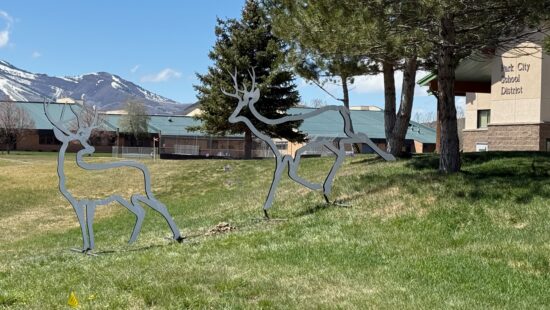NonProfit
SR224 among Utah’s deadliest roads for wildlife; Local advocacy group demands action

Supporters at the Feb. 16 City Council meeting. Photo: Save People Save Wildlife
Save People Save Wildlife is on a mission to reduce vehicle wildlife collisions and improve connectivity and safe passage for wildlife
SUMMIT COUNTY, Utah — A determined push for wildlife crossings and enhanced public safety measures on Summit County roadways is gaining traction, led by Save People, Save Wildlife (SPSW), a 501(c)(3) dedicated to advocating for safe passage—for wildlife and motorists—along the roads that lead to Park City.
Comprehensive studies commissioned by the Utah Department of Transportation (UDOT) highlight the road’s ranking as the fifth worst in Utah for vehicle-wildlife collisions, with a rate of 2.97 collisions per mile per year. Between 2010 and 2020, SR224 saw 247 such incidents, costing an estimated $7.5 million. We spoke with Erin Ferguson, president of SPSW, who outlined the approach they have taken to advocate for this infrastructure as well as next steps.
“Wildlife crossings pay for themselves over time. It does not come out of UDOT’s pocket but rather the public’s pockets and insurance claims. If the state had to pay these claims, then we would have wildlife crossings everywhere they’re needed in the state,” Ferguson said.
Research points to wildlife crossings, fencing and cattle guards as the most effective strategies for mitigating vehicle-wildlife collisions. Fencing guides wildlife to crossings that allow safe passage. Two critical locations for potential wildlife corridors have been identified near McPolin Farm and Swaner Preserve, hoping to connect habitat spaces without leading wildlife into residential areas.
“Deer, elk, and moose are the most vulnerable in this area because they are surrounded by open and protected space that has no boundaries for them to live within,” Ferguson said.
Additionally, with the upcoming 2034 Olympics and the expected increase in traffic, the financial and environmental costs of inaction are projected to rise significantly. The proposed Bus Rapid Transit (BRT) expansion on SR224, increasing the road width from 82 feet to 115 feet, could exacerbate the problem without a concurrent focus on wildlife safety measures. It’s noted that wider roadways can lead to higher perceived safe driving speeds, potentially increasing collision risks.
“The BRT project prompted our launch for this area along with years of activists reaching out to SPSW to do something about the heinous loss of wildlife and bloodshed on SR224. The entire Snyderville basin is a wildlife habitat, with the City and County preserving more open space to protect the habitat. Vehicle traffic continues to increase,” Ferguson said. “The SR224 transformation started in 1941, and since then, 30,000+ vehicles travel daily, only to increase with the Olympics coming.”
At the heart of SPSW’s efforts is the recognition of the diverse stakeholders involved—from local communities concerned with safety to hunters lamenting the loss of wildlife on roads. Ferguson detailed the organization’s efforts to raise awareness and funds, including hosting “friendraisers” and forming an outreach committee. Despite initial challenges, their persistence led to a significant victory: the allocation of state funds for wildlife fencing on I80.
In regards to SR224, “We have been successful with tiny steps, but we are still working on getting acceptance for truly effective measures. UDOT is awaiting Park City’s support and go ahead to make it a priority before they will make it a priority.”
Ferguson sees the community as playing a “critical role” in future efforts. “Nann Worel, the mayor of Park City, communicated to SPSW that it was essential for the community to weigh in with letters of support in order for this issue to become a priority for Park City,” Ferguson said.
On Feb. 15, SPSW urged the Park City Council to prioritize the reduction of vehicle-wildlife collisions and the establishment of safe wildlife passage along SR224 in its strategic planning. In terms of next steps, Ferguson said we must get “all key players to act as one in applying for funding. It is up to Park City to make this a priority for UDOT to pursue the grant application. Irrespective of the grant, we still need Park City to make this a priority so we can find funding for this and move forward with design and construction.”
Since its founding in 2015, SPSW has raised over a quarter of a million dollars for wildlife crossings. Ferguson explained, “Private sector funding, in addition to state matching funds, will enhance our chances of securing a federal grant. SPSW has co-shared with UDOT when there was no budget for wildlife fencing. SPSW has purchased 12 silhouettes for driver awareness along SR224, with the newest additions coming this spring. SPSW is prepared to enhance the grant opportunity with the funding received from the public to sweeten the pot for the grant approval, showing how much the public supports this.”
When asked about other roadways, Ferguson remarked, “We have already done much on I-80 and are evaluating SR248 and US40 as areas with high vehicle-wildlife collisions. SR224 is our priority right now, and that doesn’t mean other roadways aren’t in need of safe passage.”
Ferguson asserted, “Safe passage should be for all: for the wildlife, vehicles, pedestrians, cyclists, tourists, transit vehicles and domestic animals that lose their way. We all count, no matter how small or how big. This is an intricate part of our community fabric that is woven into our vision plan for Park City.”

Appreciate the coverage? Help keep Park City informed.
TownLift is powered by our community. If you value independent, local news that keeps Park City connected and in the know, consider supporting our newsroom.


















